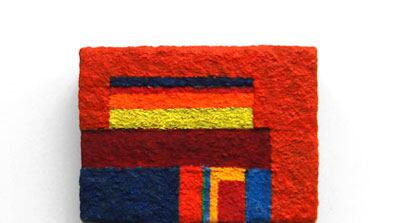Richard Dupont, the sculptor who is curating the Roy Newell show at the New York’s Carolina Nitsch gallery, first met the artist when both were in a group show in the mid 1990s. Dupont was in his mid twenties at the time and Newell was 84. “ He was cantankerous,” Dupont recalls, “Difficult. Disagreeable. Argumentative. Vulnerable—kind of a mess of a guy.”
They hit if off nonetheless and Dupont would frequently visit Newell and his wife in their cramped apartment in a Chelsea project. “He was extremely hard to be around. But he wasn’t threatened by me because I was so much younger. He would open up to me in a certain way. And I liked what he was doing. The more I went around the more I liked it. He was involved in a continuous meditation.”
Click Image to View Our Gallery of Roy Newell

Then there were the tales. “It was like a window into a much different time. I was fascinated by the romance of that,” Dupont says. “Newell grew up during the Great Depression on the Lower East Side. Orthodox Jewish community. Several siblings. It was an extremely difficult life. He never had a toy as a child and his mother was illiterate. He took to art as a way of escaping his reality.”
In New York in the ‘40s immediately before the flowering of still unnamed Abstract Expressionism, the art reference room in the New York Public Library was a major meeting place for young artists and that was where Roy Newell, who was self-taught, met Willem de Kooning. “That was how Roy really got pulled into the art world. De Kooning was very well connected already, knew everybody. He and Roy got along very, very well. They would drink heavily together.”
Newell also became close to Franz Kline. They would meet every day at Rikers, the local soup kitchen, and lunch on the 25-cent chicken pot pie. “But Kline’s career was really beginning to take off astronomically,” Dupont notes. “Once he drove up to this soup kitchen in a brand-new Ferrari that he had traded to a collector for a painting.”
Newell meanwhile, experimented with gestural abstraction in the 1950s. “He was hot,” Dupont says. “He was showing at one of the top galleries in New York. He was in the Whitney’s annual painting show a couple of years in a row. And he was in a number of important group shows. He was also the subject of a profile in the New Yorker. And then he stopped doing what he was doing. And he started on this new path.
“While all of his contemporaries were exploring the expansive canvas and the big gesture Newell was working in miniature. His work is very much ahead of a lot of other artists. But he was through.”
Newell remained close to de Kooning and Kline. But he wasn’t happy living in their shadows. And he wasn’t shy about it. “It resulted in an extremely confrontational and argumentative persona,” Dupont says. “He would tell de Kooning exactly what he thought was wrong with his work. In a way that was not nice! He had no social graces. He was very rough and he was abrupt. But de Kooning seemed to rise above all this. And he was one of the only ones who continued to support him.”
Newell was working in a mode of Geometric Abstraction that derives from Malevich and Mondrian. He had a small group of loyal supporters—Willem and Elaine De Kooings donated a Newell to the Guggenheim—and he continued to get good reviews. But the work could not have been more deeply unfashionable, whether in the time of the Ab Exes, or later of Pop. ”People wrote it off as third or fourth generation Constructivism,” Dupont says.
Newell stuck grimly to his guns, doggedly painting and repainting, but he sold few, and it wore him down. “His whole life had been such a disappointment,” Dupont recalls. “He was extremely cynical. Did he think is time would come? He was deeply disappointed that it hadn’t. His two best friends had become two of the greatest artists of all time. And nobody even knew who he was.
“That got the better of him in the early ‘60s. And that’s what drove him into the deep alcoholism. Newell was lucky to emerge from it. And by the time he cleared his head two and a half decades had gone by.”
That was when he met Dupont. And Dupont tried to get him shows.
“I showed his work to all kinds of people,” he says. “We almost hooked something up at Robert Miller in the late ‘90s. I was able to get a few pictures over there. They wanted to do a show with John McLaughlin, Peter Halley and Newell. That would have been a three generational look at Geometric Abstraction. And it would have been superb. But it wasn’t to be. Carolina Nitsch, Richard Dupont’s dealer, began at Brooke Alexander Editions. She now has two spaces in Manhattan, where she shows works on paper—for instance by Carolee Schneeman, Louise Bourgeois and Dupont himself—and she publishes editions. She had never before shown a painter but when Dupont showed her the work it appealed to her. As did Newell’s story.
Newell, who died in 2006, only completed 100 or so paintings in his lifetime. And there are paintings in Dupont’s show that he had begun working on in the 1950s and was still working on when he died. He would say that each painting contained a hundred paintings within it. Indeed the paintwork on some is an inch thick. “Making the paintings was the point. Losing himself,” Dupont says. “He would wake up, eat, take one of them down and start working on it all over again.. It was kind of maddening. But there was something else going on, something that was beyond him. That may sound weird but that’s what it was. It’s as if the art was beyond him.”
Plus: Check out Art Beast for galleries, interviews with artists, and photos from the hottest parties.
Anthony Haden-Guest is the news editor of Charles Saatchi’s online magazine.






